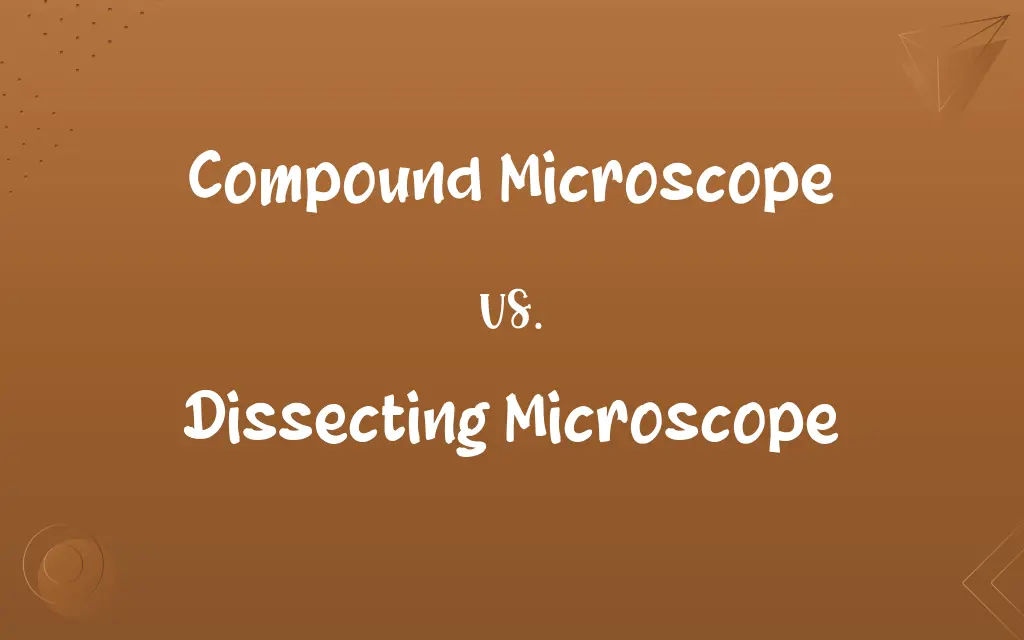Compound Microscope vs. Dissecting Microscope: Know the Difference

By Shumaila Saeed || Updated on December 25, 2023
A Compound Microscope uses multiple lenses for high magnification of small samples, while a Dissecting Microscope offers lower magnification for larger, 3D specimens.

Key Differences
A Compound Microscope provides high magnification (up to 1000x or more) and is used for viewing tiny, detailed structures of cells and bacteria. Each line of sight through a Compound Microscope reveals the intricate details of microscopic organisms. In contrast, a Dissecting Microscope, also known as a stereomicroscope, offers lower magnification (usually up to 100x), suitable for observing larger, three-dimensional specimens. It allows for a detailed examination of the surface of objects, such as insects or plants, where overall structure and spatial relationships are crucial.
Shumaila Saeed
Dec 09, 2023
The design of a Compound Microscope includes multiple lenses (objective and eyepiece lenses) that work together to create a highly magnified image. This design is ideal for studying slides with thin samples. Dissecting Microscopes, on the other hand, are designed with a lower magnification range and typically have a larger working distance, which allows for manipulation of the specimen, such as dissection or sorting.
Shumaila Saeed
Dec 09, 2023
A Compound Microscope has a limited field of view due to its high magnification, focusing on a single plane within a specimen. This makes it suitable for detailed cellular studies. A Dissecting Microscope provides a wider field of view and greater depth perception, essential for understanding the three-dimensional structure and spatial relationships of the specimen.
Shumaila Saeed
Dec 09, 2023
Compound Microscopes are extensively used in medical and biological research for examining cells, tissues, and other small-scale structures. Every observation under a Compound Microscope adds to our understanding of microscopic worlds. Dissecting Microscopes are commonly used in botany, zoology, and forensic science for studying larger specimens where the focus is on external details rather than internal structures.
Shumaila Saeed
Dec 09, 2023
Lighting in a Compound Microscope is typically from below, shining through transparent samples. This setup is essential for revealing the internal structures of specimens. In contrast, Dissecting Microscopes often use light from above the specimen, highlighting the surface details and textures of the object being examined.
Shumaila Saeed
Dec 09, 2023
ADVERTISEMENT
Comparison Chart
Structural Design
Multiple lenses for detailed viewing
Designed for larger, 3D specimens
Shumaila Saeed
Dec 09, 2023
Field of View
Limited, focuses on single planes
Wider with greater depth perception
Shumaila Saeed
Dec 09, 2023
Typical Applications
Medical, biological research
Botany, zoology, forensic science
Shumaila Saeed
Dec 09, 2023
Lighting and Sample Prep
Below the sample, for transparent specimens
Above the specimen, for surface details
Shumaila Saeed
Dec 09, 2023
ADVERTISEMENT
Compound Microscope and Dissecting Microscope Definitions
Compound Microscope
Used for viewing very small, detailed samples.
A compound microscope is essential for observing bacteria.
Shumaila Saeed
Dec 01, 2023
Dissecting Microscope
A low magnification microscope for larger specimens.
A dissecting microscope is used to examine the anatomy of a leaf.
Shumaila Saeed
Dec 01, 2023
Compound Microscope
Ideal for examining thin, transparent specimens.
Blood samples are routinely analyzed using a compound microscope.
Shumaila Saeed
Dec 01, 2023
Dissecting Microscope
Has a larger working distance for specimen manipulation.
The dissecting microscope allowed for detailed dissection of the flower.
Shumaila Saeed
Dec 01, 2023
Compound Microscope
A microscope with multiple lenses for high magnification.
Biologists use a compound microscope to study cell structures.
Shumaila Saeed
Dec 01, 2023
ADVERTISEMENT
Dissecting Microscope
Commonly used for surface examination of samples.
The textures of the rock were visible under the dissecting microscope.
Shumaila Saeed
Dec 01, 2023
Compound Microscope
Features high-resolution imaging capabilities.
The compound microscope revealed the intricate details of the plant cells.
Shumaila Saeed
Dec 01, 2023
Dissecting Microscope
Features lighting from above the specimen.
The dissecting microscope illuminated the intricate details of the butterfly's wings.
Shumaila Saeed
Dec 01, 2023
Compound Microscope
Has a complex lens system for enhanced image clarity.
The compound microscope provided clear images of the tissue sample.
Shumaila Saeed
Dec 01, 2023
Dissecting Microscope
Provides a three-dimensional view of the specimen.
Students observed the insect using a dissecting microscope.
Shumaila Saeed
Dec 01, 2023
Repeatedly Asked Queries
Can a compound microscope view live cells?
Yes, it's used for observing live microscopic organisms.
Shumaila Saeed
Dec 09, 2023
What specimens are best for a compound microscope?
Thin, transparent samples like cells and tissues.
Shumaila Saeed
Dec 09, 2023
What is a dissecting microscope?
A lower magnification microscope for 3D specimens.
Shumaila Saeed
Dec 09, 2023
Is a dissecting microscope suitable for surgery?
It's used for detailed work but not typically for human surgery.
Shumaila Saeed
Dec 09, 2023
Do compound microscopes have a deep field of view?
No, they focus on single planes with limited depth.
Shumaila Saeed
Dec 09, 2023
Can you study bacteria with a dissecting microscope?
No, bacteria require higher magnification, like a compound microscope.
Shumaila Saeed
Dec 09, 2023
What's the typical magnification of a dissecting microscope?
Usually up to 100x.
Shumaila Saeed
Dec 09, 2023
Is a compound microscope used in schools?
Yes, particularly in advanced biology classes.
Shumaila Saeed
Dec 09, 2023
What is a compound microscope?
A high-magnification microscope with multiple lenses.
Shumaila Saeed
Dec 09, 2023
Can a dissecting microscope be used for electronics?
Yes, for examining circuit boards and components.
Shumaila Saeed
Dec 09, 2023
Is a compound microscope good for studying plant anatomy?
Yes, for internal structures, but surface details are better with a dissecting microscope.
Shumaila Saeed
Dec 09, 2023
What lighting is used in a compound microscope?
Typically, transmitted light from below the sample.
Shumaila Saeed
Dec 09, 2023
Can you observe live insects in a compound microscope?
No, a dissecting microscope is better for live, larger specimens.
Shumaila Saeed
Dec 09, 2023
Can dissecting microscopes magnify as much as compound microscopes?
No, their magnification is generally lower.
Shumaila Saeed
Dec 09, 2023
Do both microscopes use slides?
Compound microscopes use slides; dissecting microscopes do not always require them.
Shumaila Saeed
Dec 09, 2023
What's the working distance of a dissecting microscope?
It has a larger working distance for specimen handling.
Shumaila Saeed
Dec 09, 2023
Are dissecting microscopes portable?
Many are more portable than compound microscopes.
Shumaila Saeed
Dec 09, 2023
Can compound microscopes show 3D images?
No, they provide 2D images due to their high magnification.
Shumaila Saeed
Dec 09, 2023
Do dissecting microscopes use reflected light?
Yes, they use light reflected from above the specimen.
Shumaila Saeed
Dec 09, 2023
What's the price range of a compound microscope?
Varies widely, from affordable to very expensive for advanced models.
Shumaila Saeed
Dec 09, 2023
Share this page
Link for your blog / website
HTML
Link to share via messenger
About Author
Written by
Shumaila SaeedShumaila Saeed, an expert content creator with 6 years of experience, specializes in distilling complex topics into easily digestible comparisons, shining a light on the nuances that both inform and educate readers with clarity and accuracy.









































































